Towards Sustainability: New Tools for Planning Urban Pedestrian Mobility
Abstract
:1. Introduction
- promote smart mobility (car sharing, carpooling, smart parking and bike sharing);
- promote cycle and pedestrian mobility (paying attention to the inclusion of non-disabled and disabled individuals);
- discourage the circulation of private cars in downtown urban areas;
- promote local public transport.
- safe: with reduced interactions with vehicles (parked or in motion);
- connected: so that they have continuity between the different origins and destinations;
- pleasant: well-sized and integrated into the territory, with slopes and lengths that are not excessive, etc.;
- usable for as many people as possible;
- Sketch plan models: used as a planning guide as they attempt to approximate pedestrian demand based on a simple rule of thumb [15]. Pedestrian volumes are predicted through the use of counts and regression analyses as a function of land use (such as the surface of offices or commercial spaces) and/or travel generation indicators (parking capacity, transit volumes, movements of traffic, etc.) [16,17,18,19,20]. The advantage of these models is that they require minimal data collection and no knowledge of mathematical simulation or computer modeling. They are able to offer quick pedestrian volume estimates but are only effective at the aggregate level. These models have been applied in large urban environments where neither high precision nor detailed estimates are required [16,18,21].
- Demand driven or origin–destination models. These models resemble traditional models of vehicular travel demand in many respects [22,23]; in fact, to estimate the pedestrian volume, they use four sub-models (trip generation and distribution, modal split and assignment). These approaches are based on the utility maximization theory, i.e., that all pedestrian actions are performed for a reason and therefore have utility with respect to a set goal. The disadvantage is linked to the fact that in the choice of the route a defined number of routes is considered [22,24] with few possible deviations. Ultimately, it can be said that these models offer complex descriptions of the built environment and the pedestrian behavior within it. However, they require a large volume of data, a high level of specialized technical skills and take time to set up, calibrate and review. To simulate and reconstruct pedestrian trips, two main modelling approaches can be usually identified.
- Microsimulation models in which the behavior of the single user is reconstructed through his speed and interaction with other pedestrians, following predefined rules of behavior. Such models offer highly realistic simulations of small areas such as single streets or intersections and enclosed spaces such as transit centers, airports and shopping malls. This allows researchers to create large-scale forecasts of demand and travel volumes at a given point [25,26,27,28]. The most popular models are cellular automata [29,30], intelligent agents [31,32] and agent-based models [33,34]. These models allow a high level of detail to be obtained, but on the other hand, they require a good understanding of mathematics as well as excellent computer skills. Furthermore, critical issues are related to their calibration based on experimental data.
- Macrosimulation models aggregate pedestrian movements in terms of flow, density and average travel speed. These are made up of partial differential equations from fluid dynamics; they take into account the conservation of mass and possibly an equilibrium equation of the moment [35]. The mathematical theory of models is based on temporal and one-dimensional dynamics, respecting the laws of conservation of flow. With macrosimulation models, it is possible to estimate demand, supply and their interaction, starting from statistical physical and behavioral laws (flow curves, generalized cost of transport, etc.).
- Land use models (Seamless pedestrian models) are regression models used to explain “the levels of demand recorded in the counts as a function of the measured characteristics of the adjacent environment” [36]; in fact, they represent travel behavior based on the characteristics of an area (e.g., population density, employment density, family income, type of structure) and land use (schools, transit stops, parks, beaches, shops and civic facilities (libraries, post offices and government buildings)). They are simple to use as they take advantage of readily available data and methods [37]. Their drawback is that they are limited in terms of the acquisition of behavioral structure and are not transferable due to the relatively small sample size and characteristics upon which the models are built. In addition, the statistical significance is usually rather low.
- Configurational models allow the ways in which the built environment can influence the dynamics of movement of pedestrians to be understood. These are more detailed than sketch plan models and can estimate volumes for street sections and intersections over an entire city or neighborhood. However, the models present varying techniques as a function of the amount of walking trips in a study area and the various algorithms for choosing the route. Most models consider the behavior of human beings; people do, in fact, choose linear paths that seem shorter to travel, as can be seen from the visual data [23,38]. Since these models are less complex than the others, they are also less expensive from a computational point of view; this allows for quick and easy modeling with different scenarios. This category includes the Space Syntax which uses a graphic “proximity” algorithm to estimate the movement potentials of pedestrians.
2. Materials and Methods
- connectivity: it is a local variable that indicates the number of elements directly connected to a space;
- choice: represents the flow present through a space (a high value is obtained when there are short paths that connect several spaces);
- integration: it is a global measure of accessibility that indicates the minimum number of steps of a graph necessary to reach a point from another; this parameter can be evaluated either locally, by means of a so-called “topological radius” (usually equal to 3) or a buffer-based metric (usually 400 m) [43,44] which appears to be the best predictor of small-scale movements [45,46,47] or globally (with a topological radius n) which predicts large-scale movements (including vehicle movements, because people on longer journeys will tend to read the grid in a more globalized way) [48]. This index presents several mathematical formulations [49,50,51,52], the most immediate seems to be the one reported by Raford and Regland [13]:
3. Results
4. Discussion
- the constant term appears to be similar for both weekdays and pre-holiday days, thus providing evidence that there is a “basic level” of pedestrian activity that is irrespective of the specific day of week;
- the slope of the model was apparently different; as a matter of fact, it was clearly higher for pre-holiday days, thus providing evidence that there is a greater propensity of citizens to move on foot in the days before holidays (perhaps also due to the presence of several local market areas that are able to attract more customers also coming from the surrounding towns).
5. Conclusions
Author Contributions
Funding
Institutional Review Board Statement
Informed Consent Statement
Data Availability Statement
Conflicts of Interest
References
- Dupuy, G. The Automobile Annexe: Symptômes, Analyzes, Dagnostic, Traitements. Paris, Economica-Anthropos. 1999. Available online: https://www.persee.fr/doc/aru_0180-930x_2000_num_86_1_2325_t1_0162_0000_2 (accessed on 18 August 2021).
- Urry, J. The ‘System’ of Automobility. Theory Cult. Soc. 2004, 21, 25–39. [Google Scholar] [CrossRef] [Green Version]
- Bartzokas-Tsiompras, A.; Paraskevopoulos, Y.; Sfakaki, A.; Photis, Y.N. Addressing street network accessibility inequities for wheelchair users in fifteen European city centers. In Conference on Sustainable Urban Mobility; Springer: Cham, Switzerland, 2020; pp. 1022–1031. [Google Scholar]
- Campisi, T.; Basbas, S.; Tesoriere, G.; Trouva, M.; Papas, T.; Mrak, I. How to Create Walking Friendly Cities. A Multi-Criteria Analysis of the Central Open Market Area of Rijeka. Sustainability 2020, 12, 9470. [Google Scholar] [CrossRef]
- Campisi, T.; Ignaccolo, M.; Inturri, G.; Tesoriere, G.; Torrisi, V. Evaluation of walkability and mobility requirements of visually impaired people in urban spaces. Transp. Bus. Manag. 2020, 2020, 100592. [Google Scholar]
- European Commission. Urban Mobility Report. 2016. Available online: http://www.trt.it/en/trip-research-themeanalysis-re-port-urban-mobility/ (accessed on 21 May 2019).
- Institute for Health Metrics and Evaluation. Housing Population Census. Global Burden of Disease. GBD Compare. Viz Hub. ISTAT. 2013. Available online: http://daticensimentopopolazione.Istat.it/Index.aspx (accessed on 5 June 2018).
- Ewing, R.; Cervero, R. Travel and the built environment. J. Am. Plan. Assoc. 2010, 76, 265–294. [Google Scholar] [CrossRef]
- Lee, C.; Moudon, A.V. The 3Ds + R: Quantifying land use and urban form correlates of walking. Transp. Res. Part D Transp. Environ. 2006, 11, 204–215. [Google Scholar] [CrossRef]
- Song, Y.; Knaap, G.J. Measuring urban form: Is Portland winning the war on sprawl? J. Am. Plan. Sociation 2004, 70, 210–225. [Google Scholar] [CrossRef]
- Kunzmann, K.R. Smart cities after COVID-19: Ten narratives. Disp-Plan. Rev. 2020, 56, 20–31. [Google Scholar] [CrossRef]
- Shorfuzzaman, M.; Hossain, M.S.; Alhamid, M.F. Towards the sustainable development of smart cities through mass video surveillance: A response to the COVID-19 pandemic. Sustain. Cities Soc. 2021, 64, 102582. [Google Scholar] [CrossRef]
- Raford, N.; Ragland, D. Pedestrian Volume Modeling for Traffic Safety and Exposure Analysis; University of California Traffic Safety Center White Paper: Berkeley, CA, USA, 2005. [Google Scholar]
- Desyllas, J.; Desyllas, J.; Duxbury, E.; Ward, J.; Smith, A. Pedestrian Demand Modelling of Large Cities: An Applied Example from London; The Centre for Advanced Spatial Analysis: Sendai, Japan, 2003. [Google Scholar]
- Federal Highway Administration. Guidebook on Methods to Estimate Non-Motorized Travel: Overview of Methods; Publication No. FHWA-RD-98-165; United States Department of Transportation: McLean, VI, USA, 1999.
- 1000 Friends of Oregon. Making the Land Use Transportation Air Quality Connection; The Pedestrian Environment: 1993; Volume 4A. Available online: https://www.google.com/url?sa=t&rct=j&q=&esrc=s&source=web&cd=&ved=2ahUKEwi8i_--lL_yAhUOt4sKHQaDD0EQFnoECAMQAQ&url=http%3A%2F%2Flibraryarchives.metro.net%2FDPGTL%2Fnonlocalagencies%2F1997-making-the-connections-volume-7-portland-oregon.pdf&usg=AOvVaw3i32XSMYX2BaxBnO_URcys (accessed on 18 August 2021).
- Systematics, Cambridge. Short-Term Travel Model Improvements; DOT-T-95-05; Travel Model Improvement Program, U.S. Department of Transportation: McLean, VI, USA, 1994; pp. 2-1–2-7. [Google Scholar]
- Rossi, T.; Lawton, T.; Kim, K. Revision of Travel Demand Models to Enable Analysis of Atypical Land Use Patterns; Cambridge Systematics, Inc. and Metropolitan Service District: Medford, MA, USA, 1993. [Google Scholar]
- Navin, P.; Wheeler, R. Pedestrian Flow Characteristics. Traffic Eng. 1969, 39, 31–36. [Google Scholar]
- Pushkarev, B.; Zupan, J. Pedestrian Travel Demand. Highw. Res. Rec. 1971, 355, 37–53. [Google Scholar]
- Ercolano, J.; Olson, J.; Spring, D. Sketch-Plan Method for Estimating Pedestrian Traffic for Central Business Districts and Suburban Growth Corridors. Transp. Res. Rec. 1997, 1578, 38–47. [Google Scholar] [CrossRef]
- Hoodgendoorn, S.; Bovy, P. Pedestrian route-choice and activity scheduling theory and models. Transp. Res. Part B 2004, 38, 169–190. [Google Scholar] [CrossRef]
- McNally, M. The Four-Step Model. In Handbook of Transport Modelling; Hensher, D.A., Button, K.J., Eds.; Emerald Group Pub Ltd.: Bingley, UK, 2000. [Google Scholar]
- Hamacher, H.; Tjandra, S. Mathematical modeling of evacuation problems: A State of the Art. Pedestr. Evacuation Dyn. 2001, 2001, 59–74. [Google Scholar]
- Schadschneider, A. Traffic Flow: A Statistical Physics Point of View. Phys. A Stat. Mech. Its Appl. 2002, 313, 153–187. [Google Scholar] [CrossRef]
- Lovas, G. Modelling And Simulation Of Pedestrian Traffic Flow. Transp. Res. B 1994, 28, 429–443. [Google Scholar] [CrossRef]
- Timms, P. Putting Pedestrians into Network Planning Models. In Proceedings of the 6th World Conference on Transport Research, Lyon, France, 29 June–3 July 1992. [Google Scholar]
- Annesley, T.; Dix, M.; Beswick, A.; Buchanan, P. Development and Application of Pedestrian Assignment Models In London Railway Station Studies. Traffic Eng. Control 1989, 30, 345–352. [Google Scholar]
- Blue, V.J.; Adler, J.L. Using Cellular Automata. Microsimulation to Model Pedestrian Movements. In Proceedings of the 14th International Symposium on Transportation and Traffic Theory, Jerusalem, Israel, 20–23 July 1999; Elsevier Science: Amsterdam, The Netherlands, 1999. [Google Scholar]
- Blue, V.J.; Adler, J.L. Cellular Automata Microsimulation of Bidirectional Pedestrian Flows. Transp. Res. Board 2000, 1678, 135–141. [Google Scholar] [CrossRef]
- Burstedde, C.; Klauck, K.; Schadschneider, A.; Zittartz, J. Simulation of pedestrian dynamics using a two-dimensional auto-mation. Phys. A Stat. Mech. Its Appl. 2001, 295, 507–525. [Google Scholar] [CrossRef] [Green Version]
- Wang, T.; Chen, J. An improved cellular automation model for urban walkway bi-directional pedestrian flow. In Proceedings of the IEEE International Conference on Measuring Technology and Mechateronics Automation, Zhangjiajie, China, 11–12 April 2009. [Google Scholar]
- Batty, M. Agent-based pedestrian modeling. Environ. Plan. B Plan. Des. 2001, 28, 321–326. [Google Scholar] [CrossRef] [Green Version]
- Schadschneider, A.; Kirchner, A.; Nishinari, K. CA Approach to Collective Phenomena in Pedestrian Dynamics. In International Conference on Cellular Automata; Springer: Berlin/Heidelberg, Germany, 2002; pp. 239–248. [Google Scholar]
- Hughes, R.L. A continuum theory for the flow of pedestrians. Transp. Res. Part B Methodol. 2002, 36, 507–535. [Google Scholar] [CrossRef]
- Kuzmyak, J.R.; Walters, J.; Bradley, M.; Kockelman, K.M. Nchrp Report 770—Estimating Bicycling and Walking for Planning and Project Development: A Guidebook; Transportation Research Board: Washington, DC, USA, 2014. [Google Scholar]
- Jones, M.G.; Ryan, S.; Donlon, J.; Ledbetter, L.; Ragland, D.R.; Arnold, L. Seamless Travel: Measuring Bicycle and Pedestrian Activity in San Diego County and its Relationship to Land Use Transportation. Safety and Facility Type; Report No. UCB-ITS-PRR-2010-12; Final Report for Task; Department of Transportation, State of California: Los Angeles, CA, USA, 2010. [Google Scholar]
- Teklenburg, J.A.F.; Timmermans, H.J.P.; van Wagenberg, A. Space Syntax: Standardised Integration Measures and Some Sim-ulations. Environ. Plan. B 1993, 20, 347–357. [Google Scholar] [CrossRef] [Green Version]
- Cervero, R.; Radisch, C. Travel Choices in Pedestrian versus Automobile Oriented Neighborhoods; Working Paper 644; University of California at Berkeley: Berkeley, CA, USA, 1995. [Google Scholar]
- Landis, B.; Ottenberg, R.; Vattikuti, V. The Roadside Pedestrian Environment: Toward A Comprehensive Level of Service; Paper 990570; TRB, National Research Council: Washington, DC, USA, 1999. [Google Scholar]
- Kitamura, R.; Mokhtarian, P.A.; Laidet, L. A micro-analysis of land use and travel in five neighborhoods in the San Francisco Bay Area. Transportation 1997, 24, 125–158. [Google Scholar] [CrossRef]
- Hillier, B.; Shinichi, I. Network effects and psychological effects: A theory of urban movement. In International Conference on Spatial Information Theory; COSIT 2005; Springer: Ellicottville, NY, USA, 2005; pp. 475–490. [Google Scholar]
- Bin, J.; Claramunt, C.; Klarqvist, B. An Integration of Space Syntax into GIS for Modeling Urban Spaces. Int. J. Appl. Earth Obs. Geoinf. 2000, 2, 161–171. [Google Scholar]
- Di Pinto, V. Reading and Communicating the Landscape for an Interpretative Model of the Perceived Urban Space. Ph.D. Thesis, University of Naples Federico II, Napoli, Italy, 2013. [Google Scholar]
- Hiller, B.; Penn, A.; Hanson, J.; Grajewski, T.; Xu, J. Natural movement: Or configuration and attraction in urban pedestrian movement. Environ. Plan. B Plan. Des. 1993, 20, 29–66. [Google Scholar] [CrossRef] [Green Version]
- Lerman, Y.; Rofè, Y.; Omer, I. Using Space Syntax to Model Pedestrian. Movement in Urban Transportation Planning. Geo-Graph. Anal. 2014, 46, 392–410. [Google Scholar] [CrossRef]
- Dai, W.; Yu, X. A configurational exploration of pedestrian and cyclist movements: A case study of Hangzhou, China. In Proceedings of the Ninth International Space Syntax Symposium, Seoul, Korea, 31 October–3 November 2013. [Google Scholar]
- Hillier, B. Space is the Machine: A Configurational Theory of Architecture; Space Syntax: London, UK, 1996. [Google Scholar]
- Jiang, B.; Claramunt, C. Integration of space syntax into GIS: New perspectives for urban morphology. Trans. GIS 2002, 6, 151–162. [Google Scholar] [CrossRef]
- Ostwald, M.J. The Mathematics of Spatial Configuration: Revisiting, Revising and Critiquing Justified Plan Graph Theory. Nexus Netw. J. 2011, 13, 445–470. [Google Scholar] [CrossRef] [Green Version]
- Xu, Y.; Rollo, J.; Jones, D.S.; Esteban, Y.; Tong, H.; Mu, Q. Towards Sustainable Heritage Tourism: A Space Syntax-Based Analysis Method to Improve Tourists’ Spatial Cognition in Chinese Historic Districts. Buildings 2020, 10, 29. [Google Scholar] [CrossRef] [Green Version]
- Volchenkov, D.; Blanchard, P. Scaling and Universality in City Space Syntax: Between Zipf and Matthew. Phys. A Stat. Mech. Its Appl. 2008, 387, 2353–2364. [Google Scholar] [CrossRef] [Green Version]
- Al_Sayed, K. Space Syntax Methodology. Bartlett School of Architecture; UCL: London, UK, 2018. [Google Scholar]
- Penn, A.; Dalton, N. The architecture of society: Stochastic simulation of urban movement. In Simulating Societies: The Computer Simulation of Social Phenomena; Routledge: London, UK, 1994. [Google Scholar]
- ISTAT. Territorial Bases and Census Variables. Available online: https://www.istat.it/it/archive/104317 (accessed on 28 November 2017).
- D’Apuzzo, M.; Santilli, D.; Evangelisti, A.; Pelagalli, V.; Montanaro, O.; Nicolosi, V. An exploratory step to evaluate the pe-destrian exposure in urban environment. In Computational Science and Its Applications—ICCSA 2020 VII; Springer: Cagliari, Italy, 2020; pp. 645–657. [Google Scholar]

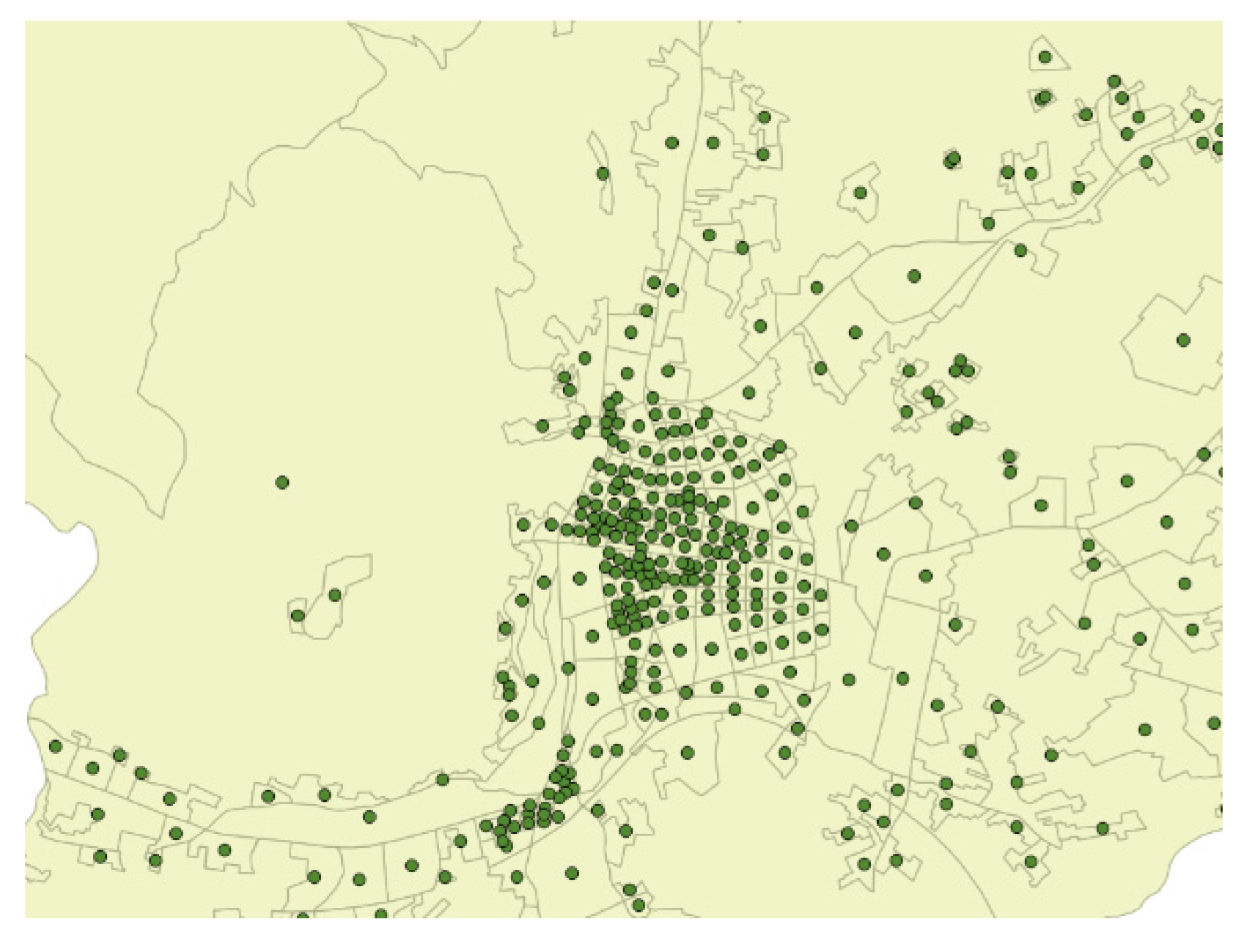

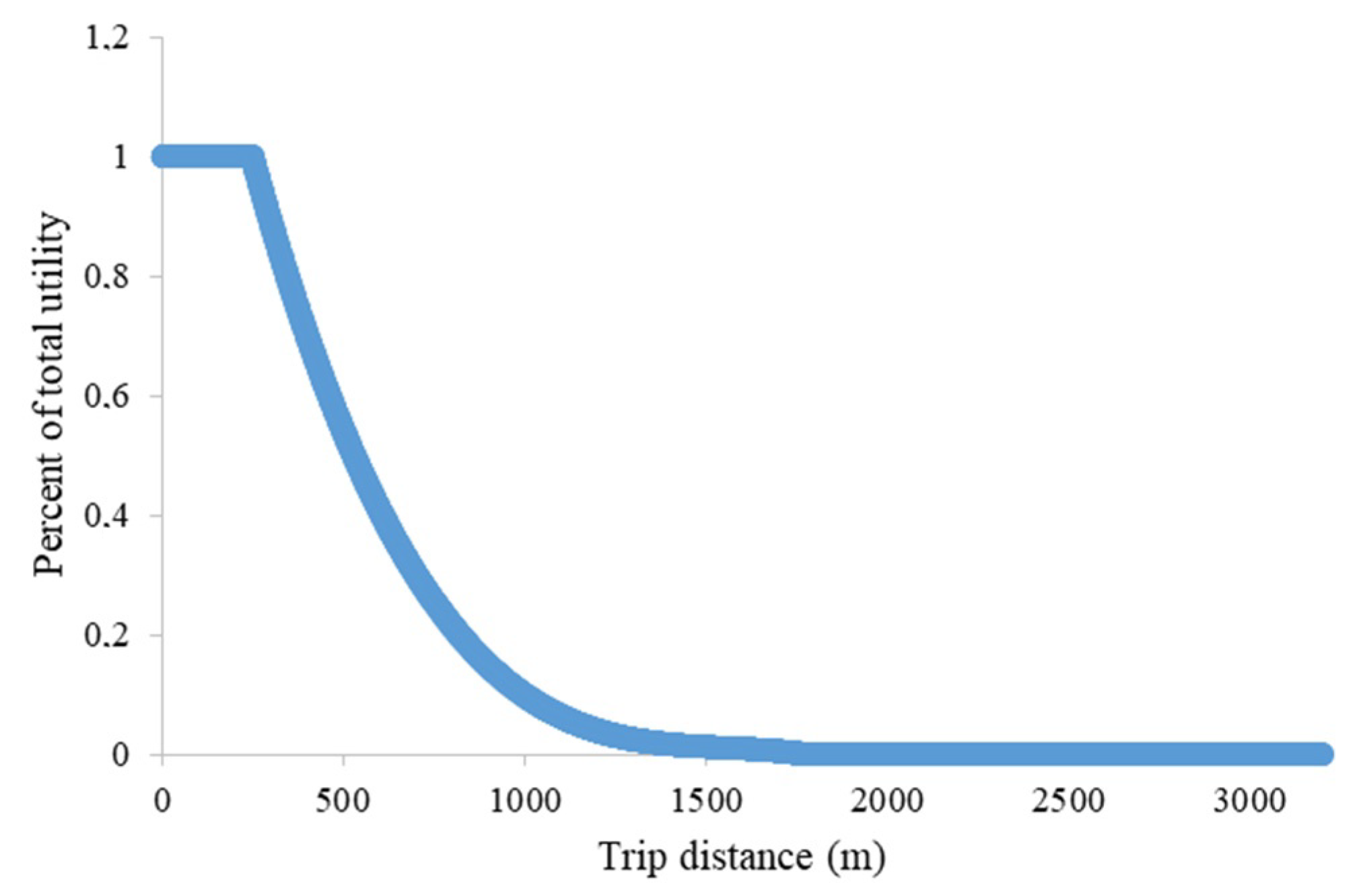
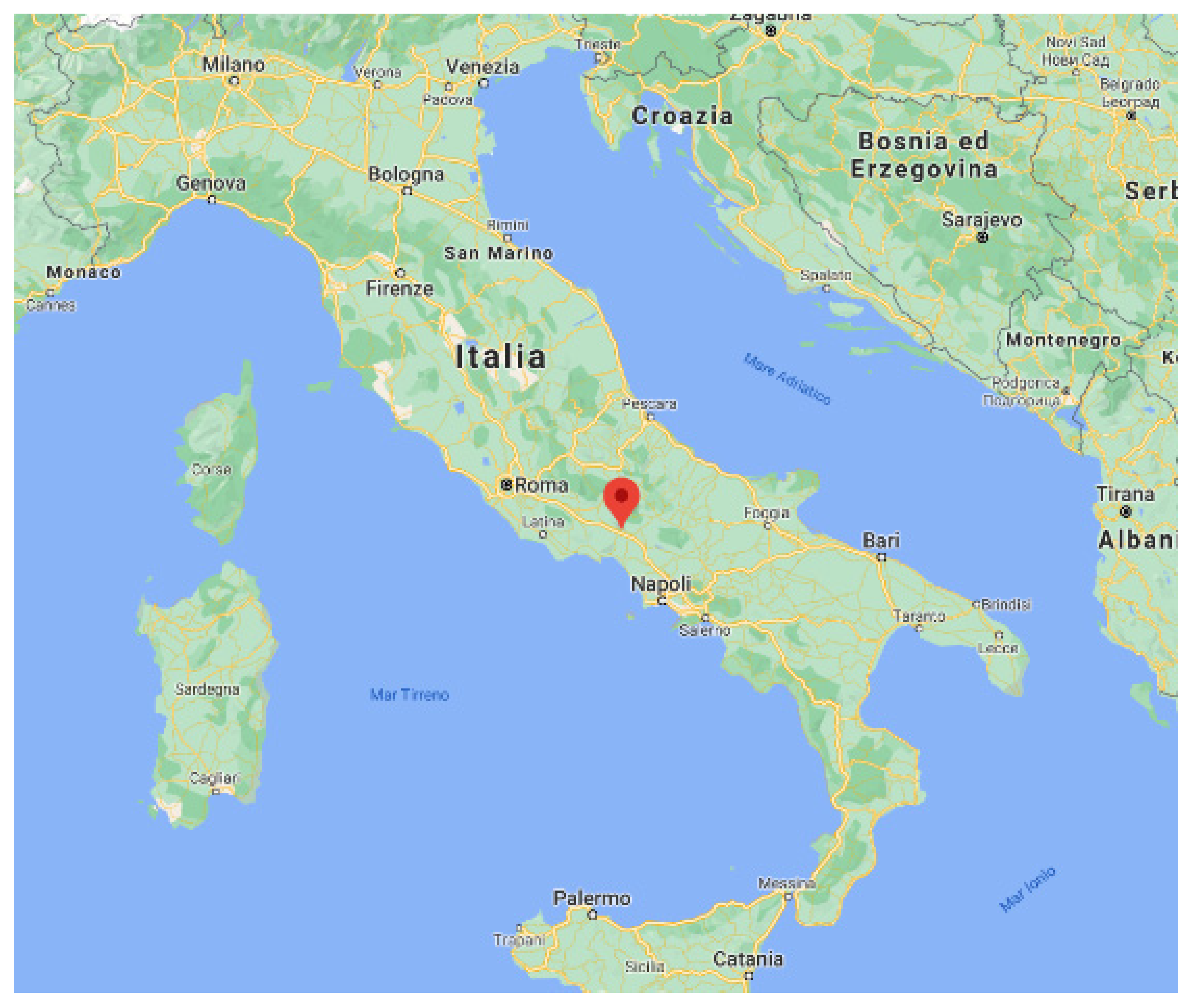
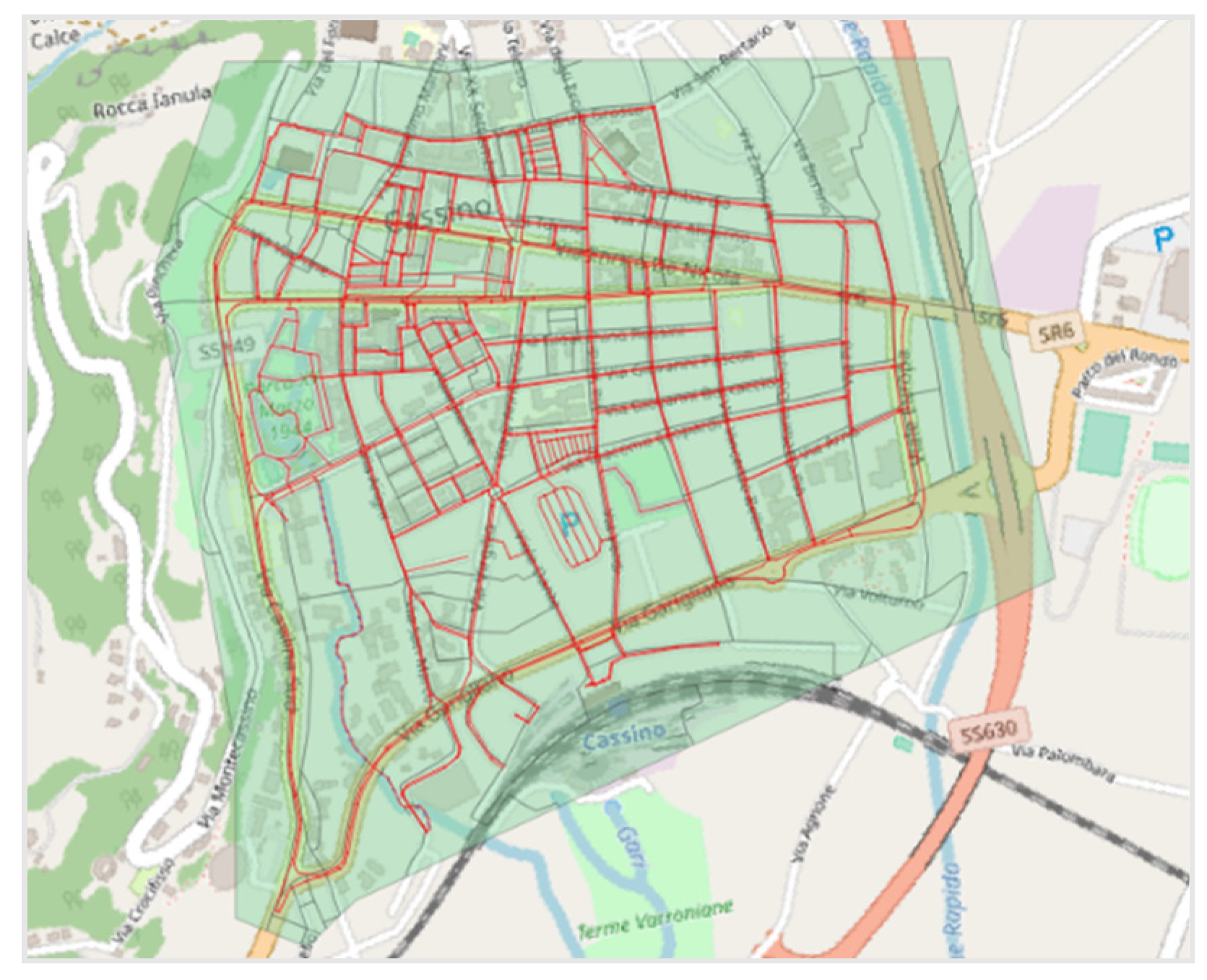
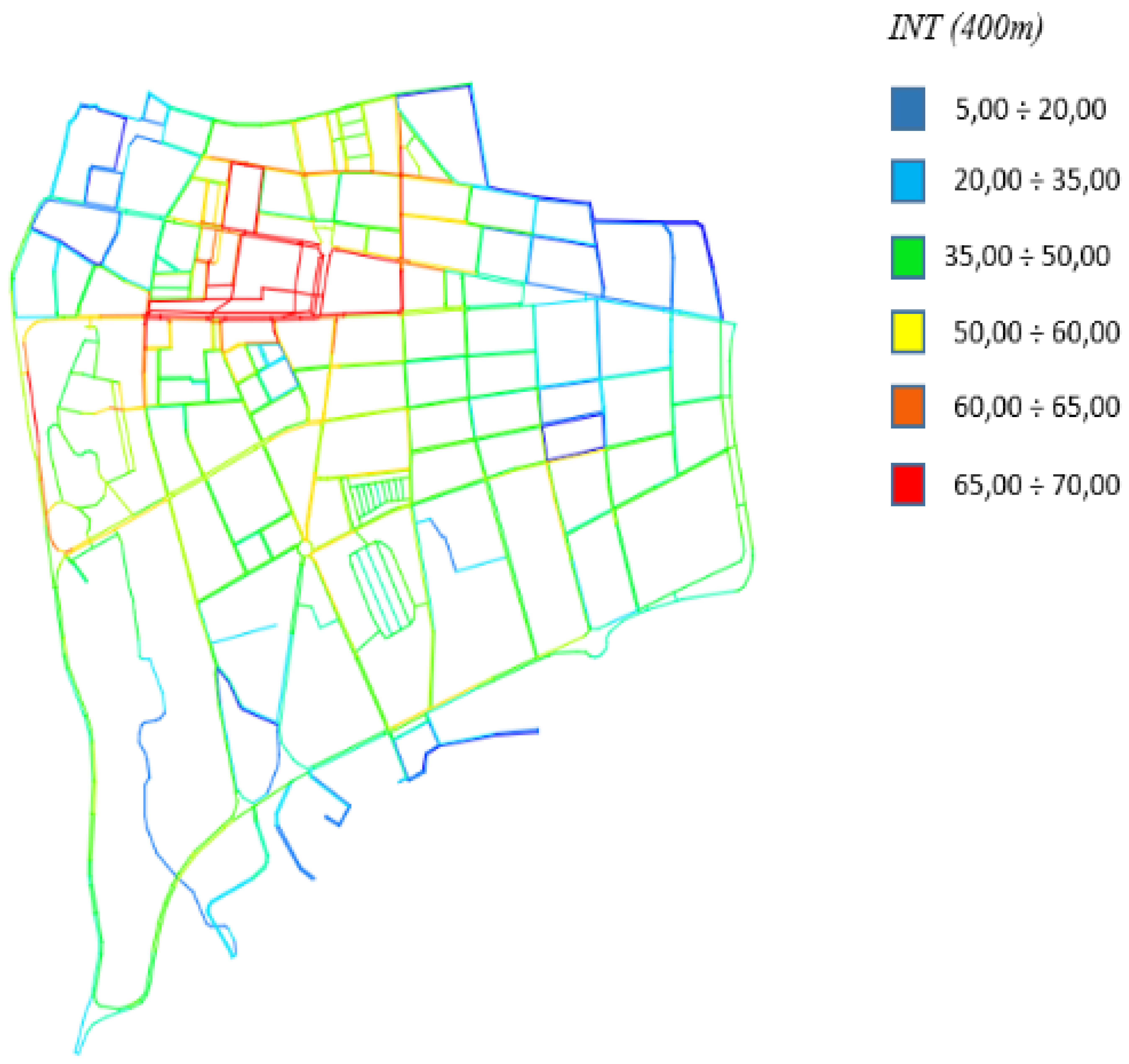
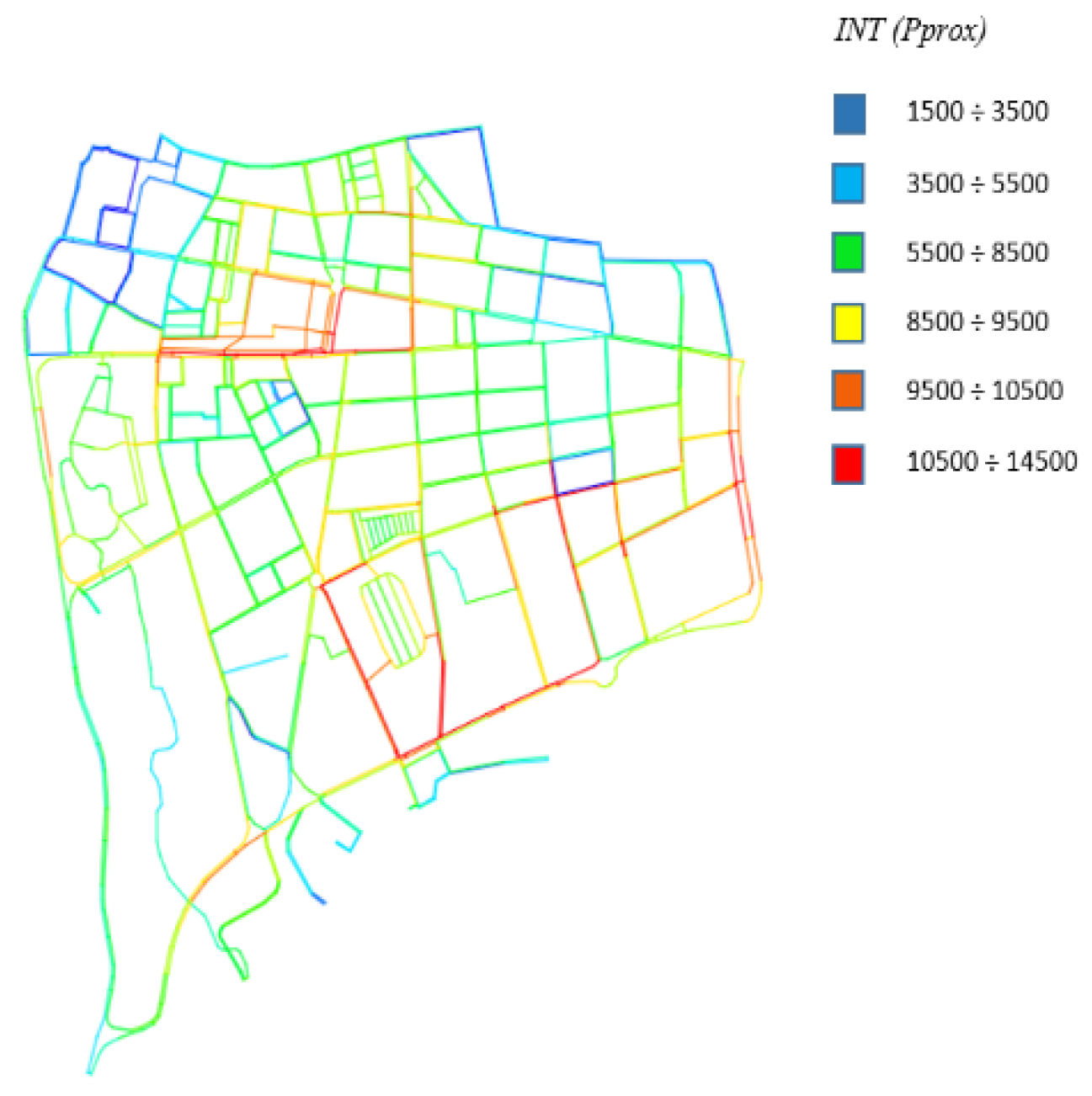
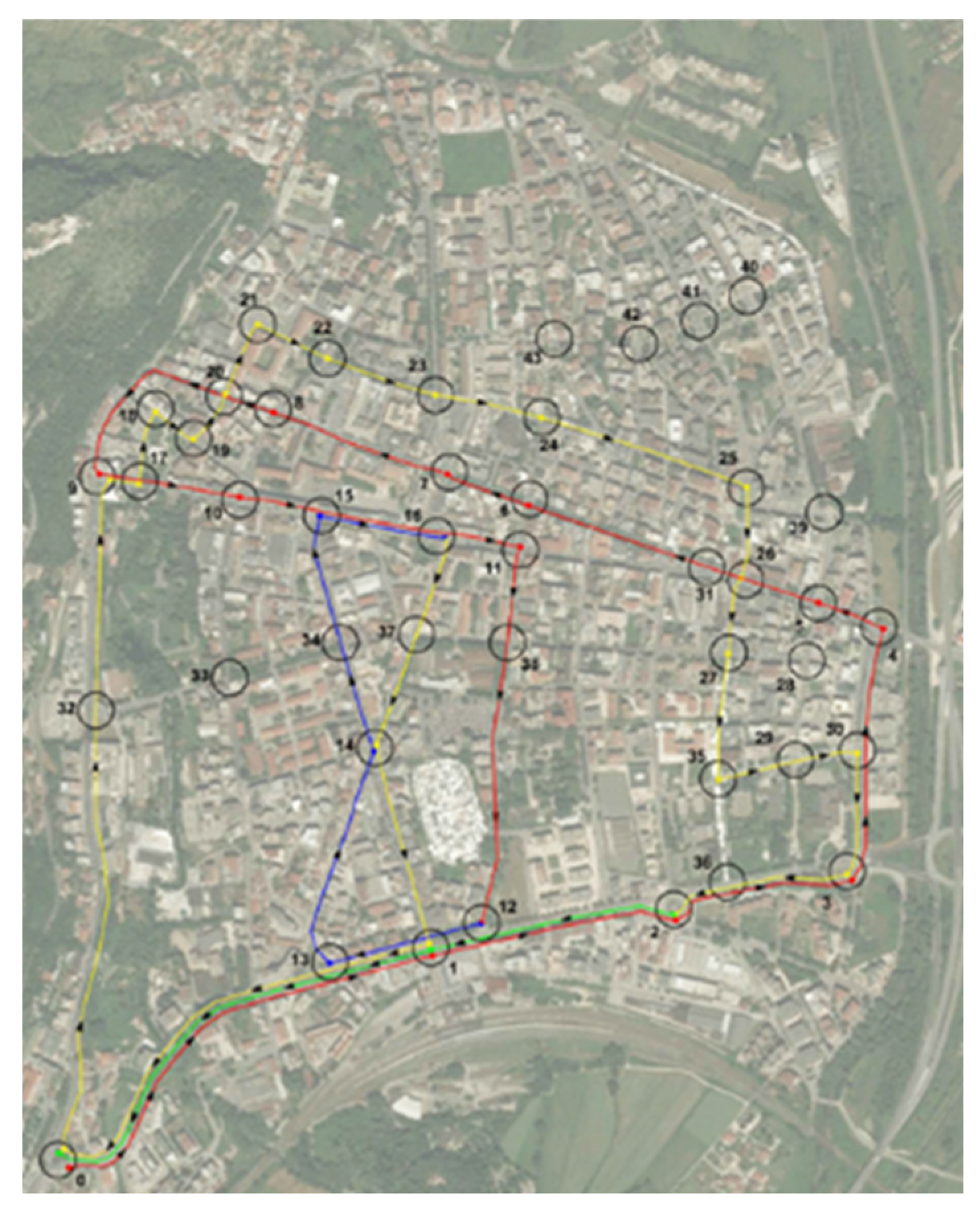
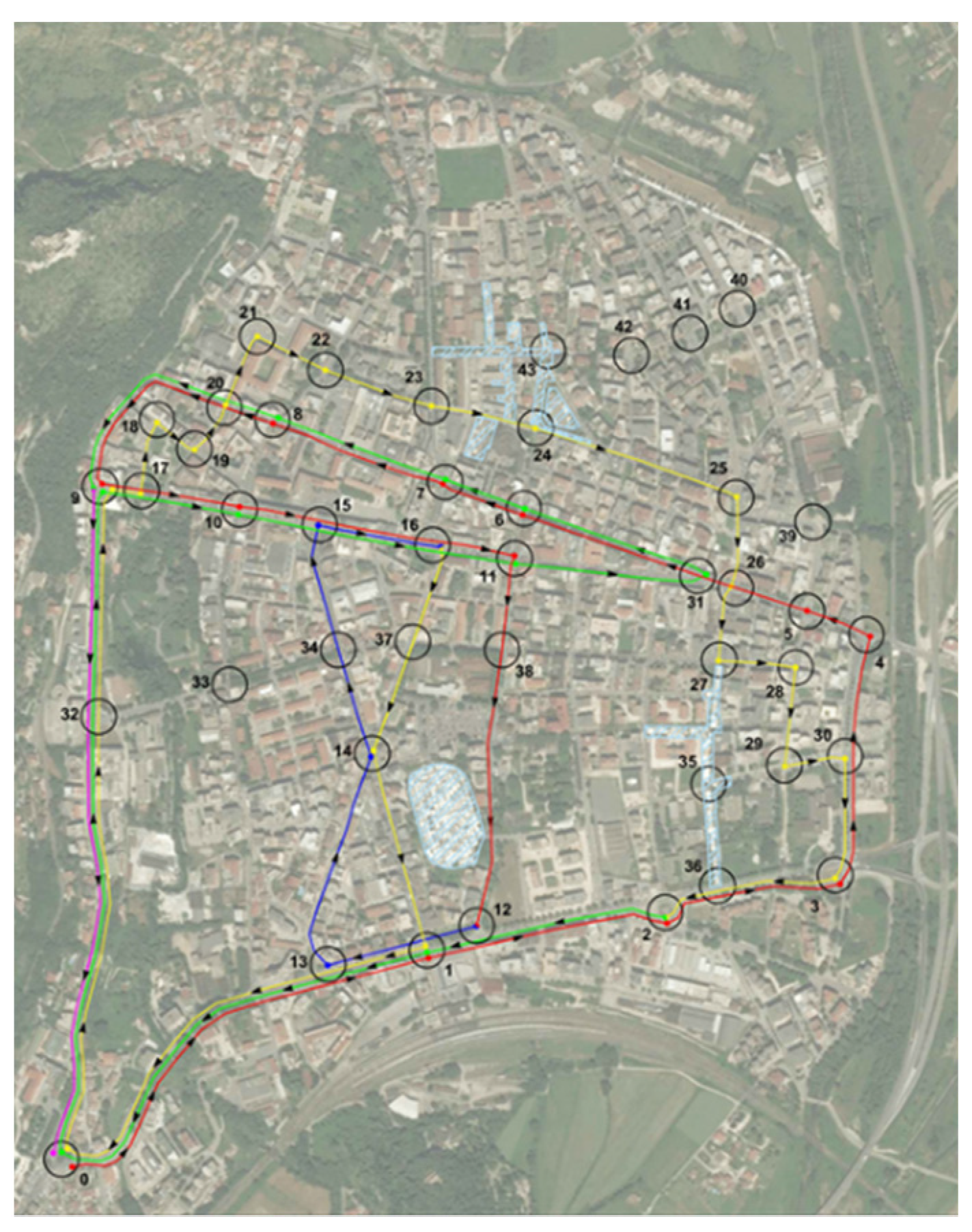
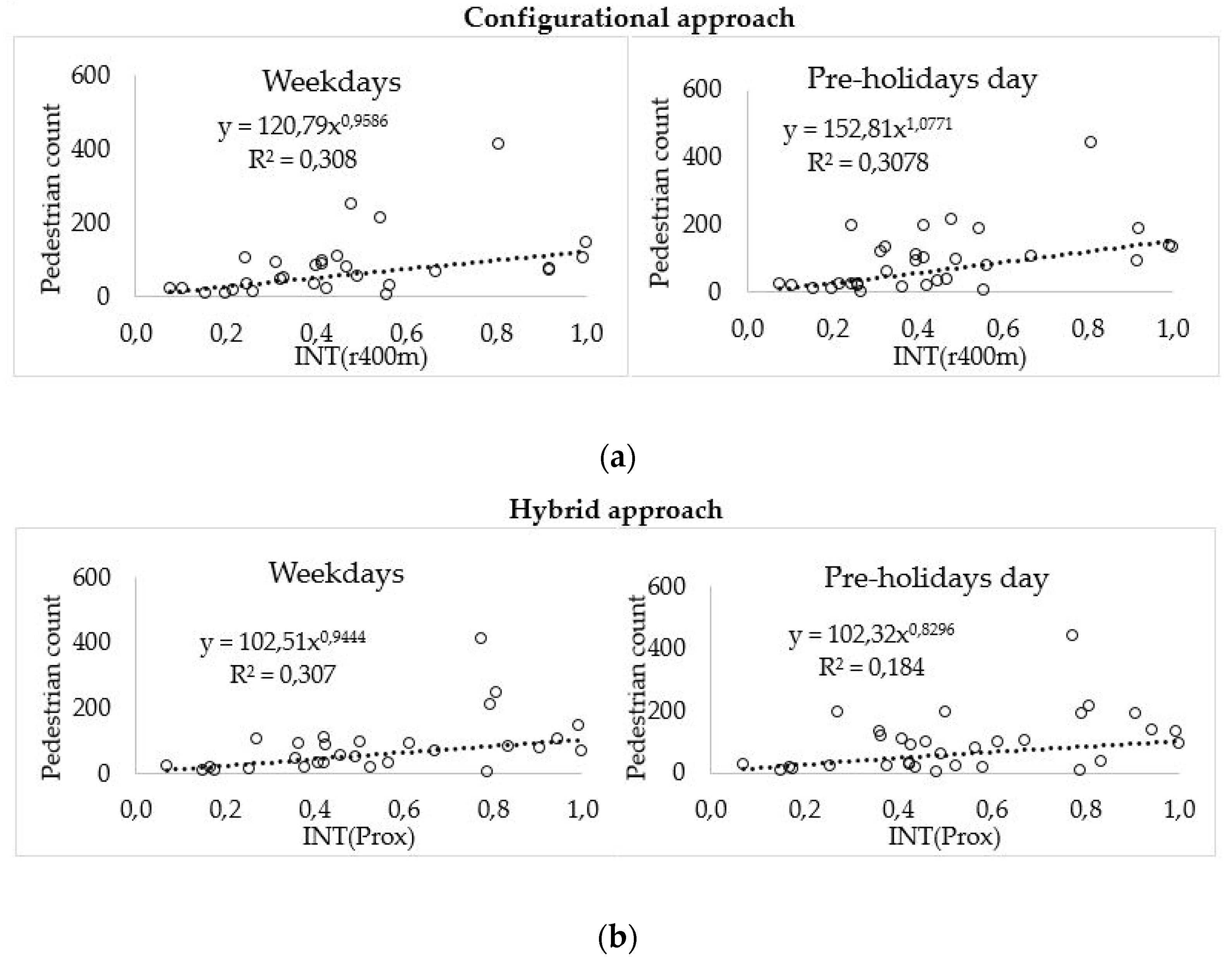

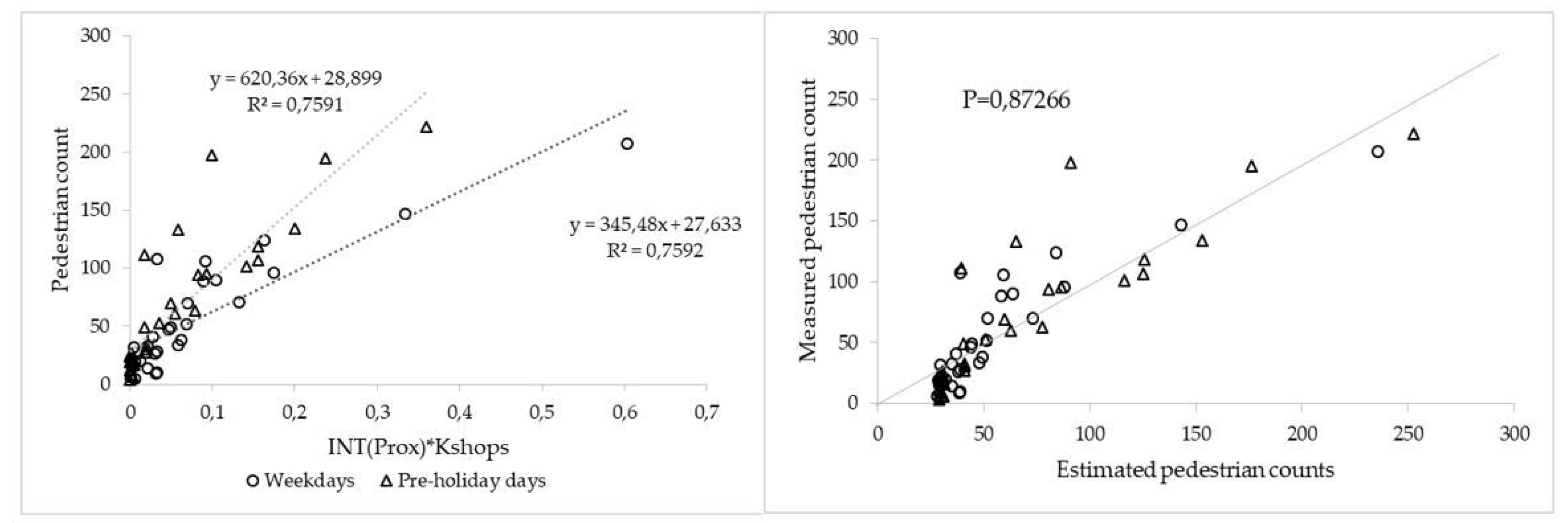
| Pre-Holiday Days | Weekdays | ||||||||
|---|---|---|---|---|---|---|---|---|---|
| Model | |||||||||
| N° observations | 32 | 29 | |||||||
| Sum of residuals | −8.05407296411431E-10 | −6.51939657814182E-9 | |||||||
| Average residual | −2.51689780128572E-11 | −2.24806778556615E-10 | |||||||
| Residual sum of squares (Absolute) | 27.216.1823810779 | 15.919.5603658666 | |||||||
| Residual sum of squares (Relative) | 27.216.1823810779 | 15.919.5603658666 | |||||||
| Standard Error of the Estimate | 30.119861875003 | 24.2819551701248 | |||||||
| Coeff. of Multiple Determination (R2) | 0.7590762769 | 0.7592199078 | |||||||
| Proportion of Variance Explained | 75.90762769 % | 75.92199078 % | |||||||
| Adjusted coeff. of Multiple Determination (Ra2) | 0.7510454862 | 0.7503021266 | |||||||
| Durbin–Watson statistic | 1.41447158255192 | 1.8936011290373 | |||||||
| (a) Regression Variable Results | (b) Regression Variable Results | ||||||||
| Variable | Value | St. Er. | t-ratio | Prob(t) | Value | St. Er. | t-ratio | Prob(t) | |
| a | 620.3528 | 63.8080 | 9.7221 | 0.00000 | 345.4754 | 37.4422 | 9.2268 | 0.00000 | |
| b | 28.8985 | 6.5563 | 4.4077 | 0.00012 | 27.6331 | 5.4085 | 5.1091 | 0.00002 | |
Publisher’s Note: MDPI stays neutral with regard to jurisdictional claims in published maps and institutional affiliations. |
© 2021 by the authors. Licensee MDPI, Basel, Switzerland. This article is an open access article distributed under the terms and conditions of the Creative Commons Attribution (CC BY) license (https://creativecommons.org/licenses/by/4.0/).
Share and Cite
Santilli, D.; D’Apuzzo, M.; Evangelisti, A.; Nicolosi, V. Towards Sustainability: New Tools for Planning Urban Pedestrian Mobility. Sustainability 2021, 13, 9371. https://doi.org/10.3390/su13169371
Santilli D, D’Apuzzo M, Evangelisti A, Nicolosi V. Towards Sustainability: New Tools for Planning Urban Pedestrian Mobility. Sustainability. 2021; 13(16):9371. https://doi.org/10.3390/su13169371
Chicago/Turabian StyleSantilli, Daniela, Mauro D’Apuzzo, Azzurra Evangelisti, and Vittorio Nicolosi. 2021. "Towards Sustainability: New Tools for Planning Urban Pedestrian Mobility" Sustainability 13, no. 16: 9371. https://doi.org/10.3390/su13169371
APA StyleSantilli, D., D’Apuzzo, M., Evangelisti, A., & Nicolosi, V. (2021). Towards Sustainability: New Tools for Planning Urban Pedestrian Mobility. Sustainability, 13(16), 9371. https://doi.org/10.3390/su13169371






